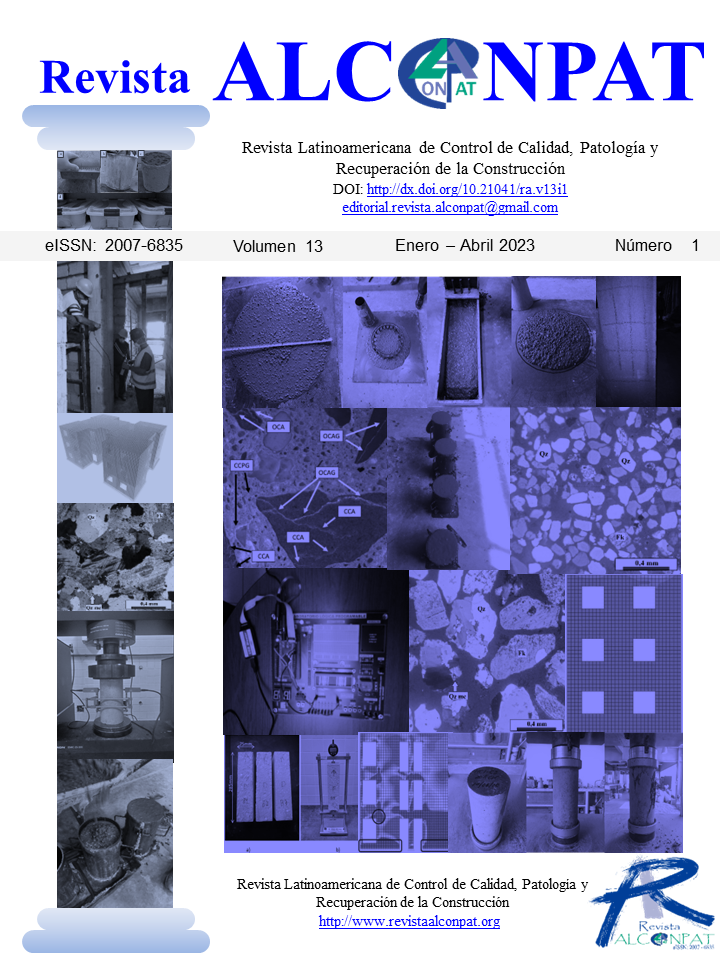Rules-based embedded system applied to the determination of structural health in multilevel buildings
DOI:
https://doi.org/10.21041/ra.v13i1.611Keywords:
structural health monitoring, relative displacement, programmable logic, rules-based systemAbstract
The objective of the work was to develop a rules-based system that supports determining the structural health of multi-level buildings. Hardware description techniques using programmable logic using entity integration and hierarchical design with VHDL programming are used. The system is embedded in an FPGA which, using an algorithm, integrates a first stage where a group of ultrasound sensors collect a measure that is interpreted to obtain the relative displacement of the mezzanine. In the second stage an inference engine performs the evaluation. We present results using an experimental model where it was verified that the system was able to determine the stability of the structure based on the parameter relative displacement of mezzanine.
Downloads
References
Arias, D., De la Colina, J. (2018), Assessment of methodologies to estimate displacements from measured acceleration records. Measurement. 114:261-273. https://doi.org/10.1016/j.measurement.2017.09.019
Bao, X., Chen, L. (2012), Recent progress in distributed fiber optic sensors. Sensors. 12(7):8601-8639. https://doi.org/10.3390/s120708601
Breuer, P., Chmielewski, T., Górski, P., Konopka, E. (2002), Application of GPS technology to measurements of displacements of high-rise structures due to weak winds. Journal of Wind Engineering and Industrial Aerodynamics. 90(3):223-230. https://doi.org/10.1016/S0167-6105(01)00221-5
Chatterjee, S., Sarbartha, S., Sirshendu, H., Nilanjan, D., Amira, S., Valentina, E. (2017), Particle swarm optimization trained neural network for structural failure prediction of multistoried RC buildings. Neural Computing and Applications. 28:2005–2016. https://doi.org/10.1007/s00521-016-2190-2
Ghasemi, M. R., Nobahari, M., Shabakhty, N. (2018), Enhanced optimization-based structural damage detection method using modal strain energy and modal frequencies. Engineering with Computers. 34:637–647. https://doi.org/10.1007/s00366-017-0563-5
Guo, J., Xie, X., Bie, R., Sun, L. (2014), Structural health monitoring by using a sparse coding-based deep learning algorithm with wireless sensor networks. Personal and Ubiquitous Computing. 18:1977–1987. https://doi.org/10.1007/s00779-014-0800-5
Li, J., Hao, H. (2016), Health monitoring of joint conditions in steel truss bridges with relative displacement sensors. Measurement. 88:360-371. https://doi.org/10.1016/j.measurement.2015.12.009
Li, X. Q., Chen, Q. J., Ding, Z. D. (2019), Structural damage diagnosis and fine scale finite element intelligence simulation of long span cable stayed bridges. Cluster Computing. 22: 4101–4107. https://doi.org/10.1007/s10586-017-1515-y
Maxinez, D., Alcalá, J. (2007), VHDL El arte de programar sistemas digitales. México, CECSA, 5th. ed., cap 1, pp. 1-31.
Moosazade, S., Namazi, E., Aghababael, H., Marto, A., Mohamad, H., Hajihassani, M. (2019), Prediction of building damage induced by tunnelling through an optimized artificial neural network. Engineering with Computers. 35(2):579–591. https://doi.org/10.1007/s00366-018-0615-5
Park, H. S., Kim, J. M., Choi, S. W., Kim, Y. (2013), A Wireless Laser Displacement Sensor Node for Structural Health Monitoring. Sensors. 13(10):13204-13216. https://doi.org/10.3390/s131013204
Paulay, T., (2001) Some design principles relevant to torsional phenomena in ductile buildings. Journal of Earthquake Engineering. 5(3):273-308. https://doi.org/10.1080/13632460109350395
Song, H. X., Wang, X. D., Ma, L. Q., Cai, M. Z., Cao, T. Z. (2006), Design and performance analysis of laser displacement sensor based on Position Sensitive Detector (PSD). Journal of Physics: Conference Series. 48:217-222. http://dx.doi.org/10.1088/1742-6596/48/1/040
Tamura, Y., Matsui, M., Pagnini, L. C., Ishibashi, R., Yoshida, A. (2002), Measurement of wind-induced response of buildings using RTK-GPS. Journal of Wind Engineering and Industrial Aerodynamics. 90:1783-1793. https://doi.org/10.1016/S0167-6105(02)00287-8
Zrelli, A., Ezzedine, T. (2017), Collect Tree Protocol for SHM system using wireless sensor networks. 13th International Wireless Communications and Mobile Computing Conference (IWCMC):1797-1801. https://doi.org/10.1109/IWCMC.2017.7986556
Downloads
Published
How to Cite
Issue
Section
License
_______________________________
License in effect from September 2020
You are free to:
- Share — copy and redistribute the material in any medium or format for any purpose, even commercially.
- Adapt — remix, transform, and build upon the material for any purpose, even commercially.
- The licensor cannot revoke these freedoms as long as you follow the license terms.
Under the following terms:
- Attribution — You must give appropriate credit , provide a link to the license, and indicate if changes were made . You may do so in any reasonable manner, but not in any way that suggests the licensor endorses you or your use.
- No additional restrictions — You may not apply legal terms or technological measures that legally restrict others from doing anything the license permits.
Notices:
You do not have to comply with the license for elements of the material in the public domain or where your use is permitted by an applicable exception or limitation .
No warranties are given. The license may not give you all of the permissions necessary for your intended use. For example, other rights such as publicity, privacy, or moral rights may limit how you use the material.





















.png)














